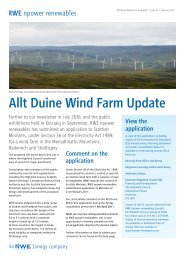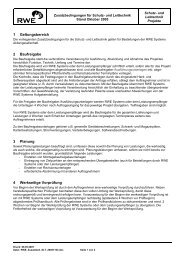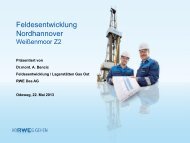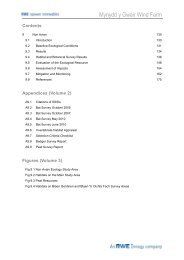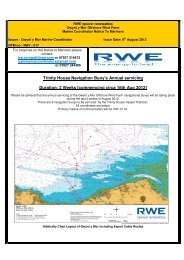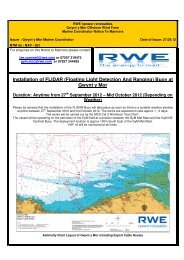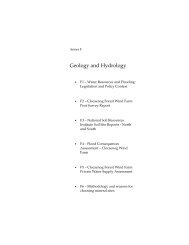Key Stage 3 fact Sheet – wind power - RWE
Key Stage 3 fact Sheet – wind power - RWE
Key Stage 3 fact Sheet – wind power - RWE
You also want an ePaper? Increase the reach of your titles
YUMPU automatically turns print PDFs into web optimized ePapers that Google loves.
<strong>Key</strong> <strong>Stage</strong> 3 <strong>fact</strong> <strong>Sheet</strong> <strong>–</strong><br />
<strong>wind</strong> <strong>power</strong><br />
The <strong>wind</strong> is a form of solar energy. The sun makes the <strong>wind</strong> blow by heating<br />
the atmosphere unevenly, causing warm air to rise and cooler air to blow in to<br />
replace it. Wind turbines use the <strong>wind</strong> to generate electricity.<br />
The UK is the <strong>wind</strong>iest country in Europe, and <strong>wind</strong><br />
energy is the largest renewable electricity source<br />
in the UK. There are already enough <strong>wind</strong> turbines<br />
in the UK to <strong>power</strong> over two million homes.<br />
History<br />
No one knows who invented the <strong>wind</strong>mill, but<br />
we do know that Chinese people were using<br />
<strong>wind</strong> <strong>power</strong> to pump water for their crops 4,000<br />
years ago, and people were using <strong>wind</strong> <strong>power</strong> to<br />
drive boats at least 5,000 years ago on the River<br />
Nile in Egypt. In the early 19th century there<br />
were over 10,000 <strong>wind</strong>mills in use in Britain,<br />
mainly used to grind corn, which is where the<br />
An old-fashioned <strong>wind</strong> mill<br />
word “<strong>wind</strong>mill” comes from. However, when<br />
coal became cheap, during the industrial<br />
revolution, <strong>wind</strong> <strong>power</strong> became much less used<br />
in Europe. Today there are currently 2,539 <strong>wind</strong><br />
turbines in the UK (as of July 2009).<br />
Windmills began to be used<br />
to make electricity towards<br />
the end of the 19th<br />
century. This is the first<br />
automatically operating<br />
<strong>wind</strong> turbine for generating<br />
electricity, built in 1888 in<br />
the inventor’s back yard.<br />
Modern <strong>wind</strong> turbines produce lots<br />
more <strong>power</strong> than old style <strong>wind</strong>mills.<br />
The old corn milling machines were<br />
up to 23 metres high. By comparison,<br />
the world’s biggest <strong>wind</strong> turbine,<br />
which is in Germany, has a tower 138<br />
metres high and can produce about<br />
200 times as much <strong>power</strong>. A typical<br />
modern <strong>wind</strong> turbine has a tower that is<br />
approximately 80 metres high, and will<br />
produce enough electricity each year<br />
to meet the yearly needs of over 1,400<br />
households (equivalent to making 230<br />
million cups of tea!!!)
<strong>wind</strong> <strong>power</strong> cont…<br />
The first UK <strong>wind</strong> farm was built in Cornwall in<br />
1991. Farr Wind Farm, near Inverness, is <strong>RWE</strong><br />
n<strong>power</strong> renewables’ most <strong>power</strong>ful renewable<br />
energy project. It consists of 40 turbines. The<br />
<strong>wind</strong> farm generates enough electricity to meet<br />
the average annual needs of 54,000 homes<br />
(more than half of all the homes across the<br />
Scottish Highlands).<br />
The UK’s first large-scale offshore <strong>wind</strong> farm,<br />
North Hoyle, is located four to five miles off<br />
the North Wales coast, and was developed<br />
by <strong>RWE</strong> n<strong>power</strong> renewables in 2003.<br />
How <strong>wind</strong> turbines work<br />
<strong>–</strong> Modern <strong>wind</strong> turbines usually have three blades.<br />
<strong>–</strong> The <strong>wind</strong> turns the blades, which drive an<br />
electrical generator.<br />
<strong>–</strong> A generator is a machine that contains coils of<br />
wire and strong magnets.<br />
<strong>–</strong> When the wire coils are spun quickly inside the<br />
magnets, they generate electricity.<br />
<strong>–</strong> All electricity is produced in this way, with just<br />
different sources of energy being used to drive<br />
the generator.<br />
Advantages<br />
<strong>–</strong> Wind <strong>power</strong> does not cause climate<br />
change or pollution.<br />
<strong>–</strong> Wind is a renewable resource <strong>–</strong> as long<br />
as the sun shines and the <strong>wind</strong> blows it<br />
will never run out.<br />
<strong>–</strong> Wind energy is a cheap way to produce<br />
renewable energy.<br />
<strong>–</strong> The land underneath <strong>wind</strong> turbines can<br />
still be used for farming.<br />
<strong>–</strong> A small difference in the <strong>wind</strong> speed makes a<br />
big difference to the <strong>power</strong> output of a <strong>wind</strong><br />
turbine (when the <strong>wind</strong> speed doubles, the<br />
<strong>power</strong> in the <strong>wind</strong> is multiplied by eight).<br />
<strong>–</strong> It gets <strong>wind</strong>ier the higher up you go, which is<br />
why <strong>wind</strong> turbines are built on such tall towers.<br />
<strong>–</strong> The amount of <strong>power</strong> a <strong>wind</strong> turbine produces<br />
also depends on the size of the blade, which is<br />
why <strong>wind</strong> turbine blades are so long.<br />
<strong>–</strong> To generate the most energy, <strong>wind</strong> turbines<br />
should be located where the <strong>wind</strong> speed is<br />
highest. Some of the best places for <strong>wind</strong><br />
farms are, therefore, out at sea or by the sea,<br />
at the tops of rounded hills and between gaps<br />
in mountains.<br />
The tips of the blades of a typical <strong>wind</strong><br />
turbine move at approximately 140mph!<br />
Disadvantages<br />
<strong>–</strong> The speed of the <strong>wind</strong> is affected by many<br />
different <strong>fact</strong>ors such as weather, time<br />
of day and landscape. This makes it an<br />
intermittent source of energy, which cannot<br />
be used to generate electricity on demand.<br />
<strong>–</strong> Wind turbines can be seen from long<br />
distances, and some people do not like the<br />
way they look.




